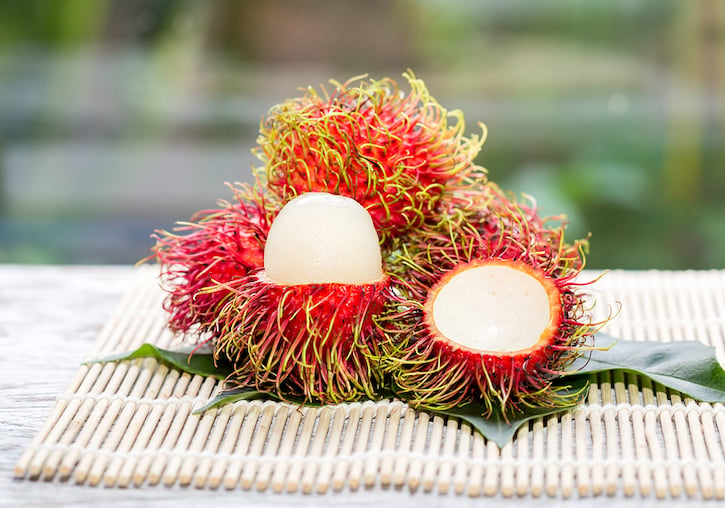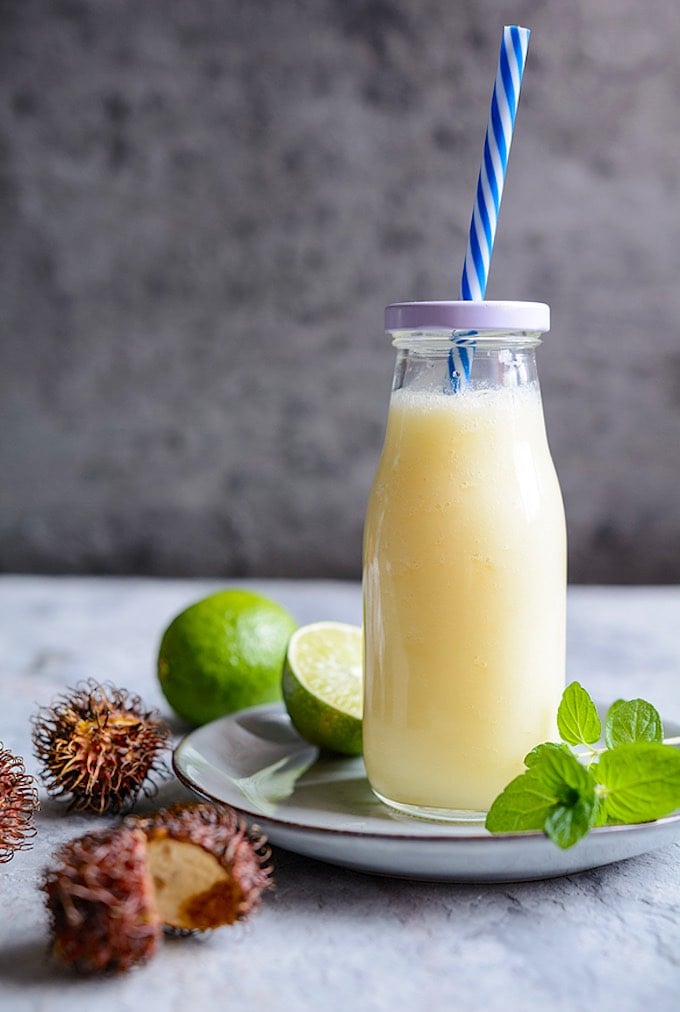The tropical rambutan fruit, native to Southeast Asia, earned its name for its hair-like greenish-yellow tendrils sprouting from its red skin. Rambutan means “hair” in the Malay language. This guide presents tips for buying prepping, and using this unusual fruit, with links to recipes.

With the shaggy exterior out of the way, rambutan reveals delicious white flesh with a single seed in the middle, similar to a lychee. The flavor can be compared to grapes, perhaps just slightly more acidic, but just as sweet.
The rambutan fruit is approximately the size of a golf ball, making it a great, if somewhat weird, grab-and-go snack. Just grab a knife to cut the outer skin and squeeze gently until the milky white center pops out.
A lychee relative: Rambutan and lychee both belong to the Sapindaceae family, and are often used interchangeably. They do have some similarities as well as some differences, which you can read about in this detailed comparison.
The following information and tips are adapted from Melissa’s Great Book of Produce by Cathy Thomas, reprinted with permission of Melissa’s Produce.

How does rambutan look and taste?
To picture rambutan, imagine a lychee that spent the night in Dr. Frankenstein’s laboratory, being fitted top to bottom with hairlike protrusions (fittingly, rambutan meaning “hair” in Malayan). The bristles don’t prohibit easy access to the luscious orb inside the shell, because they’re soft and flexible.
The shell ranges in color from crimson to orange to greenish-yellow and has a pebbly texture. It’s easily penetrable with a small knife or sturdy thumbnail. There are more than fifty varieties, but all contain a grayish-white globe that is juicy and surrounds an elongated, inedible pit.
Less fragrant than lychees, rambutans have a sweet-tart tropical flavor, a pineapple-cherry taste with a subtle tart edge, and a grape-like texture.
Buying and storing
As mentioned, this fruit originated in Southeast Asia, but it’s now being grown in Mexico, Honduras, Guatemala, and even in the U.S. It’s available year-round.
The most pertinent question is where to find rambutan. If you’re lucky, you may find it in well-stocked supermarkets in urban areas, or in Asian markets. Your best bet is to order from online sources like Melissa’s Produce, which has pretty much every fruit and vegetable under the sun. Suffice it to say that no matter where or how you purchase it, rambutan is a pricey fruit, and even more so if shipping has to be added.
Rambutan (and its related fruit, lychees) also come in cans, but the fresh fruits are so much better.
What to look for: Shells shouldn’t have any ruptures, moisture, or mold on them. Spikes should be flexible and look fresh. The fruit can be stored for 1 to 2 days at room temperature, or refrigerated in perforated plastic bag for up to 7 days.
Freezing: For longer storage, freeze whole or shelled and pitted, for up to 3 months. If frozen whole, seeds are easier to remove than when fresh. Freezing causes texture change. They become slightly mushy but still taste delicious.

How to prep rambutan
To peel, cut around equator with a small paring knife, just deep enough to penetrate the shell. Remove bottom half of shell and squeeze remaining shell. The edible white orb will pop from the shell. To remove pit, cut in half lengthwise, stopping at the pit; pull apart and cut out the pit.
Rambutan nutrition notes
Rambutan is a good source of fiber, vitamin C, some of the B vitamins and several minerals, notably copper. It’s rich in antioxidants as well. Here’s a complete look at the nutritional profile of this distinctive fruit.

How to use rambutan — ideas and recipes
Just as is: The simplest, and honestly the best way to use rambutan is to simply eat raw, just as is, or cut into large chunks to include in fruit salads.
Smoothies: Not surprisingly, rambutan makes a delectable addition to smoothies, combined with other fruits. Tropical Pineapple, Coconut, and Banana Smoothie with Rambutan.
Rambutan cocktails: This is one of the most popular uses for rambutan, and there are lots of delicious recipes on the web. Here are just a few:
- Tropical Fruit Rambutan Cocktail
- Rambutan Martini (Rambutini)
- Limoncello Rambutan Martini
- Sweet and Spicy Rambutan Cocktail
- Sparkling Rambutan Gibson
Sorbet: Rambutan is an almost ideal ingredient for sorbets. Here’s a simple Rambutan and Lime Sorbet (swap in agave for honey to make it vegan). For something a bit more exotic, try this Hibiscus and Rambutan Sorbet, which also included custard apple.
Tropical pops: Insert a possible stick into a shelled and pitted rambutan. Freeze for 2 to 3 hours and serve as an ice-cold treat, much like frozen grapes.
Chocolate coated: Place shelled and pitted rambutan halves on paper towel. Melt coating chocolate (look for coating chocolate next to berries in produce sections); it should be just warm enough to melt. Dip half of each rambutan in melted chocolate and place on waxed paper. Or, if using a pitter to remove seeds, place a small piece of crystallized ginger in seed pocket and dip half in melted chocolate. Refrigerate for at least a couple of hours.
Fruit salad with mango dressing: Make a fruit salad with rambutans and other fruit, such as pineapple, papaya, and/or dragonfruit (diced) and whole grapes. Prepare a mango dressing in food processor. Combine 2 tablespoons roughly chopped fresh mint and 1 ripe (peeled and seeded) mango, and 3 to 4 tablespoons of fresh lime juice in a food processor. Process until smoothly puréed. Divide the fruit salad among individual bowls and drizzle some of the mango dressing over the top. If desired, garnish with toasted flaked coconut.
In savory curries: Give your curries a surprising twist with tropical fruit! Rambutan, Pineapple, and Tofu Curry is a delicious example.
- Explore our roundup of 12 Unusual and Exotic Fruits to Try at Least Once.
- See more of this site’s Good Food Guides.

Melissa’s Great Book of Produce by Cathy Thomas is available wherever books are sold

Leave a Reply